![]()
![]()
![]()
Use LEFT and RIGHT arrow keys to navigate between flashcards;
Use UP and DOWN arrow keys to flip the card;
H to show hint;
A reads text to speech;
33 Cards in this Set
- Front
- Back
|
Components of the integumentary system and its function?
|
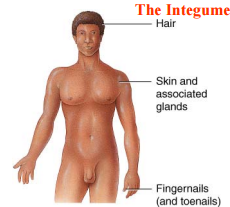
+sweat glands
Main functions: -vitamin D synthesis -detect sensation -thermo regulation |
|
|
Components and function of the muscular system?
|
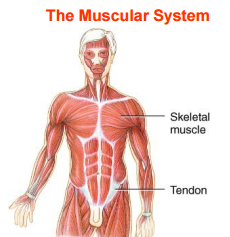
Main functions:
-movement -posture -heat Note: cardiac and smooth muscle NOT in this system |
|
|
Components and function of the skeletal system?
|
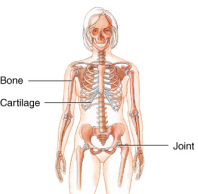
Main functions:
-support + protection -red marrow produces blood cells -yellow marrow stores lipids |
|
|
Function of megakaryocyte?
|
Produces platelets for blood clotting.
|
|
|
Functions of the haemopoetic cells?
|
Blood cells that give rise to other blood cells.
|
|
|
Components and main function of the Nervous system?
|
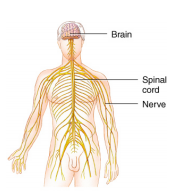
Main functions:
-Detect stimuli -> produce nerve impulse -> regulate body activities |
|
|
Components and main function of the endocrine system?
|
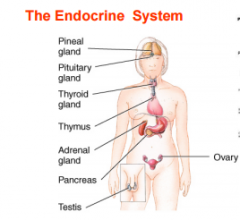
Regulate the body by releasing hormones.
|
|
|
Components and main functions of the lymphatic / immune system?
|

-defence
-transporting lipids, proteins and lymphoid cells -contributes with cardiovascular system by sending blood back into the system |
|
|
Cardiovascular system functions and components?
|
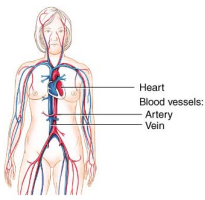
Transport O2 and CO2.
Regulate water content, temperature and acid base balance. defence. |
|
|
Respiratory system components and functions?
|

Transfer O2 and CO2 between blood and air.
|
|
|
Digestive system components and functions?
|
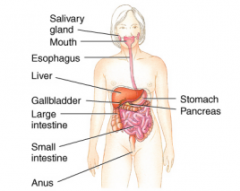
Digest food, absorb nutrients, eliminate waste.
|
|
|
Urinary system componenets and functions?
|
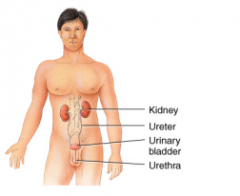
Urine production.
Storage and elimination. Regulate blood volume (assists with production of blood cells) |
|
|
What is EPO, where is it produced and what is its function?
|
Enthropoietin is a glycoprotein hormone produced in the kidney.
Signals for enthropoiesis in bone marrow. Greater activity of hemocytoblasts = more production of red blood cells = blood have greater O2 carrying capacity. |
|
|
Reproductive system components and functions?
|

Produce gametes.
Hormones regulate number of processes (testosterone) |
|
|
What tissue does the endoderm give rise to?
|
Epithelial
(lining of gastrointestinal tract) |
|
|
What tissues does the mesoderm give rise to?
|
Epithelial connective and most muscle tissue
(bone + blood) |
|
|
What tissue does the ectoderm give rise to?
|
Epithelial + nervous tissue.
(nervous system) |
|
|
What is the structure and characteristics of tight junctions?
|
Weblike strands of transmembrane proteins that fuse together the plasma membranes. The two most important proteins are claudins and occludins They seal the passageways between the cells so prevent substances leaking out to the blood/organs.
Hence found in: epithelial tissue of stomach, intestines and urinary bladder. |
|
|
Structure and characteristics of adheren junctions?
|
Have a dense layer of proteins called plaque on the inside part of the plasma membrane and is attached to the membrane proteins AND the microfilaments.
Glycoproteins called cadherins connect the cells together. It inserts through the plaque, through the plasma membrane and over the intercellular space and connects to opposite cadherins. Overall structure called adhesion 'belt'. Main functions: preventing separation between cells during contraction eg food going down the intestines. |
|
|
Structure and characteristics of desmosomes?
|
Contain plaque and cadherins, similar to adherin belts, however the plaque binds to the intermediate filaments rather than the microfilaments.
These intermediate filaments are connected from one desmosome to another on the opposite side of the cell. Helps maintain cell stability. Found mainly in epidermis of skin and cardiac muscle to prevent seperation during contraction / tension. |
|
|
Structure and characteristics of hemidesmosomes?
|
Plaque connects to the microfilaments (containing keratin). The integrins connect to the laminin in the basement membrane.
|
|
|
Structure and characteristics of gap junctions?
|
Contain membrane proteins called connexins.
These form fluid filled tunnels called connexions. Two connexions form the gap junctions. The tunnels acts as a passageway for diffusion of small molecules. Allows for cell communications. Very important in nerve cells and muscle contraction as signals can be sent through gap junctions. Note there is space between the cells. |
|
|
What does the basal membrane consist of?
|
The basal lamina (secreted by epithelial cells) and reticular lamina (secreted by connective tissue cells).
|
|
|
How do the connective tissue and epithelia tissue support each other?
|
The epithelia contains nerves, however it is avascular.
Hence it relies on the underlying connective tissue's blood vessals, which diffuse nutrients to the epithelial cells and waste from epitheliam to connnective tissue. |
|
|
What are the three main functions of the basement membrane?
|
1. It supports the overlying epitheliam.
2. Acts as a physical barrier. 3. Provides a surface for epithelial cells to fall into during wound healing (platelets for blood clotting fill this too.) note: also prevents skin cancer from invading. If it is penetrated, it will spread. |
|
|
Function and location of simple squarmous?
|
Main functions are filtration (kidneys), diffusion (lungs), secretion (serous membranes).
Endothelium - lining blood vessels Mesothelium - lining serous membranes (eg peritoneum) , ventral cavity lining. |
|
|
Function and location of simple cuboidal?
|
Secretion and absorption.
eg kidney ducts, pancreas ducts |
|
|
Function and location of simple columnar cells?
|
Non-ciliated:
Secretion and absorption. They contain microvilli and goblet cells (secrete mucus). Found in gastrointestinal tract (from stomach to anus), ducts of many glands, gall bladder. Ciliated: Moves mucus and materials. Bronchioles, fallopian tube, central canal of spinal cord, ventricles of brain. |
|
|
Function and location of stratified squarmous?
|
Keratinized: In places such as the skin for protection. Does not require secretions. protection against abrasion, water loss, microbe invasion. Nonkeratinized: In slippery places such as the mouth, throat, esophagus, anus, vagina. Requires secretions. |
|
|
Function and location of pseudostratified columnar?
|
Ciliated: Secretes mucus and moves it. found in most airways.
Non-Ciliated: Absorption and protection. This has NO goblet cells. Found in larger ducts of glands, epididymus, part of male urethra. |
|
|
Difference between endocrine glands and exocrine?
|
Endocrine glands secrete straight into the interstitial fluid and then blood. pituitary gland, pineal gland, thyroid gland.
Exocrine glands secrete into ducts that empty onto a surface of epithilium. eg sweat glands Some organs may have both like the pancreas. |
|
|
What are the two shapes of glands cells?
|
tubular (just like a tube) and alveolar (or acinar, looks like a tube with a ball at the end, think cherry)
Theres simple (one), coiled (only for tubular), branched(some branch out from the endocrine cells) and compound (many divisions of the glands) |
|
|
What is brunners gland?
|
A circular gland found in the duodenum (small intestines). It secretes alkaline mucus to neutralize the acidic substances that come from the stomach.
|

